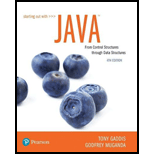
Concept explainers
When a selector name starts with a period in a JavaFX CSS style definition, it means the selector corresponds to _______.
- a. specific variable names in the application
- b. specific types of JavaFX nodes
- c. values that the user enters
- d. named constants in the application
When a selector name begins with a period in a JavaFX CSS style definition, the selector corresponds to “specific types of JavaFX nodes”.
Hence, the correct answer is option “B”.
Explanation of Solution
Type Selector Names:
- The selector names, which are starting with a period is type selector.
- Type selector is corresponding to a particular type of JavaFX nodes.
- These names are identical to the JavaFX class names to which they correspond.
- For example:
- If the class name is “Button” then the corresponding type selector is “.button”.
- If the class name is “CheckBox”, then the corresponding type selector is “.check-box”.
Explanation for incorrect options:
a. specific variable names in the application:
It is not a valid one and it does not corresponds to specific names in the JavaFX CSS style definition.
Hence, the option “A” is wrong.
c. values that the user enters:
It is not a valid one and it does not corresponds to user entered values in JavaFX CSS style definition.
Hence, the option “C” is wrong.
d. named constants in the application:
It is not a valid one and it does not corresponds to named constant in JavaFX CSS style definition.
Hence, the option “D” is wrong.
Want to see more full solutions like this?
Chapter 13 Solutions
EBK STARTING OUT W/JAVA:...DATA...
 EBK JAVA PROGRAMMINGComputer ScienceISBN:9781337671385Author:FARRELLPublisher:CENGAGE LEARNING - CONSIGNMENT
EBK JAVA PROGRAMMINGComputer ScienceISBN:9781337671385Author:FARRELLPublisher:CENGAGE LEARNING - CONSIGNMENT EBK JAVA PROGRAMMINGComputer ScienceISBN:9781305480537Author:FARRELLPublisher:CENGAGE LEARNING - CONSIGNMENT
EBK JAVA PROGRAMMINGComputer ScienceISBN:9781305480537Author:FARRELLPublisher:CENGAGE LEARNING - CONSIGNMENT Microsoft Visual C#Computer ScienceISBN:9781337102100Author:Joyce, Farrell.Publisher:Cengage Learning,
Microsoft Visual C#Computer ScienceISBN:9781337102100Author:Joyce, Farrell.Publisher:Cengage Learning, Programming with Microsoft Visual Basic 2017Computer ScienceISBN:9781337102124Author:Diane ZakPublisher:Cengage LearningProgramming Logic & Design ComprehensiveComputer ScienceISBN:9781337669405Author:FARRELLPublisher:Cengage
Programming with Microsoft Visual Basic 2017Computer ScienceISBN:9781337102124Author:Diane ZakPublisher:Cengage LearningProgramming Logic & Design ComprehensiveComputer ScienceISBN:9781337669405Author:FARRELLPublisher:Cengage





